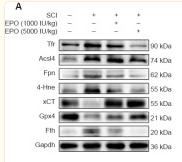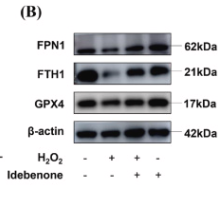SLC40A1 Antibody - #DF13561
| Product: | SLC40A1 Antibody |
| Catalog: | DF13561 |
| Description: | Rabbit polyclonal antibody to SLC40A1 |
| Application: | WB IHC |
| Cited expt.: | WB |
| Reactivity: | Human, Mouse, Rat |
| Prediction: | Pig, Zebrafish, Bovine, Horse, Sheep, Rabbit, Chicken, Xenopus |
| Mol.Wt.: | 62kDa; 63kD(Calculated). |
| Uniprot: | Q9NP59 |
| RRID: | AB_2846580 |
Related Downloads
Protocols
Product Info
*The optimal dilutions should be determined by the end user. For optimal experimental results, antibody reuse is not recommended.
*Tips:
WB: For western blot detection of denatured protein samples. IHC: For immunohistochemical detection of paraffin sections (IHC-p) or frozen sections (IHC-f) of tissue samples. IF/ICC: For immunofluorescence detection of cell samples. ELISA(peptide): For ELISA detection of antigenic peptide.
Cite Format: Affinity Biosciences Cat# DF13561, RRID:AB_2846580.
Fold/Unfold
Ferroportin 1; Ferroportin; Ferroportin-1; FPN1; HFE4; IREG1; iron regulated gene 1; Iron regulated transporter 1; Iron-regulated transporter 1; MST079; MSTP079; MTP1; putative ferroportin 1 variant IIIA; putative ferroportin 1 variant IIIB; S40A1_HUMAN; SLC11A3; SLC11A3, formerly; SLC40A1; solute carrier family 11 (proton-coupled divalent metal ion transporters), member 3; solute carrier family 11 (proton-coupled divalent metal ion transporters), member 3, formerly; solute carrier family 40 (iron-regulated transporter), member 1; Solute carrier family 40 member 1;
Immunogens
A synthesized peptide derived from human SLC40A1, corresponding to a region within N-terminal amino acids.
Detected in erythrocytes (at protein level). Expressed in placenta, intestine, muscle and spleen.
- Q9NP59 S40A1_HUMAN:
- Protein BLAST With
- NCBI/
- ExPASy/
- Uniprot
MTRAGDHNRQRGCCGSLADYLTSAKFLLYLGHSLSTWGDRMWHFAVSVFLVELYGNSLLLTAVYGLVVAGSVLVLGAIIGDWVDKNARLKVAQTSLVVQNVSVILCGIILMMVFLHKHELLTMYHGWVLTSCYILIITIANIANLASTATAITIQRDWIVVVAGEDRSKLANMNATIRRIDQLTNILAPMAVGQIMTFGSPVIGCGFISGWNLVSMCVEYVLLWKVYQKTPALAVKAGLKEEETELKQLNLHKDTEPKPLEGTHLMGVKDSNIHELEHEQEPTCASQMAEPFRTFRDGWVSYYNQPVFLAGMGLAFLYMTVLGFDCITTGYAYTQGLSGSILSILMGASAITGIMGTVAFTWLRRKCGLVRTGLISGLAQLSCLILCVISVFMPGSPLDLSVSPFEDIRSRFIQGESITPTKIPEITTEIYMSNGSNSANIVPETSPESVPIISVSLLFAGVIAARIGLWSFDLTVTQLLQENVIESERGIINGVQNSMNYLLDLLHFIMVILAPNPEAFGLLVLISVSFVAMGHIMYFRFAQNTLGNKLFACGPDAKEVRKENQANTSVV
Predictions
Score>80(red) has high confidence and is suggested to be used for WB detection. *The prediction model is mainly based on the alignment of immunogen sequences, the results are for reference only, not as the basis of quality assurance.
High(score>80) Medium(80>score>50) Low(score<50) No confidence
Research Backgrounds
May be involved in iron export from duodenal epithelial cell and also in transfer of iron between maternal and fetal circulation. Mediates iron efflux in the presence of a ferroxidase (hephaestin and/or ceruloplasmin).
Cell membrane>Multi-pass membrane protein.
Note: Localized to the basolateral membrane of polarized epithelial cells.
Detected in erythrocytes (at protein level). Expressed in placenta, intestine, muscle and spleen.
Belongs to the ferroportin (FP) (TC 2.A.100) family. SLC40A subfamily.
Research Fields
· Cellular Processes > Cell growth and death > Ferroptosis. (View pathway)
· Organismal Systems > Digestive system > Mineral absorption.
References
Application: WB Species: Rat Sample: spinal cord
Application: WB Species: Mice Sample: liver tissue
Restrictive clause
Affinity Biosciences tests all products strictly. Citations are provided as a resource for additional applications that have not been validated by Affinity Biosciences. Please choose the appropriate format for each application and consult Materials and Methods sections for additional details about the use of any product in these publications.
For Research Use Only.
Not for use in diagnostic or therapeutic procedures. Not for resale. Not for distribution without written consent. Affinity Biosciences will not be held responsible for patent infringement or other violations that may occur with the use of our products. Affinity Biosciences, Affinity Biosciences Logo and all other trademarks are the property of Affinity Biosciences LTD.




